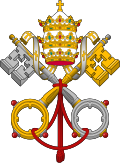Saint Peter
Apostle Peter | |
|---|---|
| Apostle, Pope, Patriarch, and Martyr | |
 Saint Peter (c. 1468) by Marco Zoppo, depicting Peter holding the Keys of Heaven and a book representing the gospel | |
| Church | Early Christian Great Church |
| See |
|
| Installed | AD 30[1] |
| Term ended | between AD 64 and 68[2] |
| Successor | |
| Orders | |
| Ordination | AD 33 by Jesus Christ |
| Personal details | |
| Birth name | Shimon (Simeon, Simon) |
| Born | c. AD 1 Bethsaida, Gaulanitis, Syria, Roman Empire |
| Died | between AD 64 and 68 (aged 62–67) Rome, Roman Empire[3][4] |
| Parents | John (or Jonah; Jona) |
| Occupation | Fisherman, clergyman |
| Sainthood | |
| Feast day |
|
| Venerated in | All Christian denominations that venerate saints, Islam |
| Canonized | Pre-Congregation |
| Attributes | Keys of Heaven, Red Martyr, pallium, papal vestments, rooster, man crucified upside down, vested as an Apostle, holding a book or scroll, Cross of Saint Peter. Iconographically, he is depicted with a bushy white beard and white hair. |
| Patronage | Patronage list |
| Shrines | St. Peter's Basilica |
Saint Peter (Greek: Πετρος, "rock")[5] also called Simon (Kephas) Peter is one of the twelve apostles of Jesus. He is often talked about in the New Testament of the Bible across the different Gospels (Matthew, Mark, Luke and John)[6]. Most of what we know about Peter comes from the Bible. In the Gospel it is written that Jesus Christ would make Peter the "rock" (foundation) of the Church (Gospel of Matthew 16:18, you are Peter (rock), and upon this rock I will build my church).
It is not known when Peter was born. But the date of his real death is said to be about the year 64 AD. He died by being nailed to a cross in Rome. This type of death is called crucifixion. According to the apocryphal Acts of Peter, Peter asked to be crucified upside down, as he felt unworthy to die as Jesus did. Most historical sources only say he was crucified this way.
The historical accuracy of the accounts of Peter's role in Rome is a matter of ongoing debate.[7][8][9]
Paintings from later centuries often show him holding the keys to the kingdom of heaven (interpreted by Roman Catholics as the sign of his primacy over the Church), a reference to Matthew 16:19.
Peter was married according to the gospel of Mark. The name of his wife is unknown.
Saint and Pope[change | change source]
The Roman Catholic, Eastern Orthodox, Oriental Orthodox, and Lutheran Churches, as well as the Anglican Communion, consider Simon Peter a saint. Roman Catholics believe that the Pope is Peter's successor. For this reason, he is the rightful head of all other bishops. Eastern and Oriental Orthodox also recognise the Bishop of Rome as the successor to Saint Peter and the Ecumenical Patriarch sends a delegation each year to Rome to participate in the celebration of his feast.
In the Ravenna document of 13 October 2007 representatives of the Eastern Orthodox Church agreed that "Rome, as the Church that 'presides in love' according to the phrase of St. Ignatius of Antioch (To the Romans, Prologue), occupied the first place in the taxis (order), and that the bishop of Rome was therefore the protos (first) among the patriarchs.[10] They disagree, however, on the interpretation of historical evidence from this era regarding the rights of the bishop of Rome as protos, a matter that was already understood in different ways in the first millennium."
Christian tradition says Saint Peter was the first leader of an early apostolic community for at least 34 years. At that time the word Pope or "Papa" was not used to name the leader of the Roman Catholic Church. At that time there was only one Christian Church. Later, the Roman Catholic Church would say that Peter was their first Pope.[11]
Tradition also locates his burial place where St. Peter's Basilica was later built, in Vatican City.
Related pages[change | change source]
References[change | change source]

- ↑ O'Connor, Daniel William (2013). "Saint Peter the Apostle". Encyclopædia Britannica. Encyclopædia Britannica Online. p. 5. Retrieved 12 April 2013.
- ↑ "Catholic Encyclopedia : St. Peter, Prince of the Apostles". www.newadvent.org.
- ↑ McDowell, Sean (2016). The Fate of the Apostles: Examining the Martyrdom Accounts of the Closest Followers of Jesus. Routledge. p. 57. ISBN 9781317031901.
- ↑ Siecienski, A. Edward (2017). The Papacy and the Orthodox: Sources and History of a Debate. Oxford University Press. ISBN 9780190650926.
scholarship largely came to accept Peter's death in Rome "as a fact which is relatively, although not absolutely, assured." While a select few were willing to make this judgment definitive
- ↑ Harris, Stephen L., Understanding the Bible. Palo Alto: Mayfield. 1985.
- ↑ "Saint Peter". Twinkl. 28 March 2010. Retrieved 28 March 2024.
{{cite web}}: CS1 maint: url-status (link) - ↑ Ehrman, Bart D.: Peter, Paul, And Mary Magdalene: The Followers of Jesus in History And Legend, Chapter 6, Oxford University Press US, 2006, ISBN 0-19-530013-0
- ↑ Keating, Karl: Catholicism and fundamentalism: The attack on "romanism" by "Bible Christians", Chapter 17, Ignatius Press, 1988, ISBN 0-89870-177-5
- ↑ Perkins, Pheme: Peter: Apostle for the Whole Church, Continuum International Publishing Group, 2000, ISBN 0-567-08743-3
- ↑ ""Ravenna Document" of 13 October, 2007".
- ↑ "List of Popes," Catholic Encyclopedia (2009); retrieved 2013-4-1.

